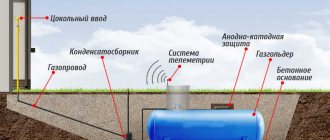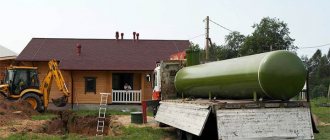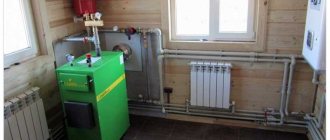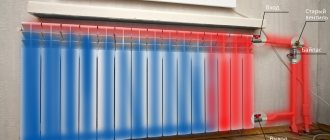Gas holder - the name was borrowed from English. Gas – gas and holder – holder, owner. Under the loud name there is simply a storage tank for a gaseous substance. Most often, residents of private houses pump and store natural or liquefied gas into such containers. Heating systems that include solid fuel or diesel boilers may often not suit homeowners due to labor-intensive maintenance.
An alternative in this case is a high-tech gas boiler, but what to do when the main gas pipeline is too far from your home, or is completely absent? A gas tank comes to the rescue. The use of such a device is not at all uncommon in the modern world. A correctly selected gas tank, depending on the volume and corresponding gas consumption of the boiler equipment, is capable of providing a country house with fuel, requiring replenishment only twice a year.
What is a gas holder?
A gas holder is nothing more than a container designed to store liquefied natural gas. If you want, this is such a huge lighter. Around the world, the use of gas tanks on households is completely common. It would never occur to a prudent owner to pull a branch from a main gas pipeline several kilometers away.
Gas holders are widely used in Europe, where resources are used sparingly and the traditions of autonomous gasification are firmly entrenched in the minds of homeowners. Often such a large cylinder can be found at ski resorts, or northern territories where it is not possible to lay a gas pipeline for geological or economic reasons.
Autonomous gasification is not hopeless at all. This is a completely sensible, balanced and widespread decision throughout the world. In the European Union, for example, Poland alone, there are more than 100 thousand similar gas supply options. Installing a gas holder helps households experience the benefits of using liquefied gas at home, such as convenience and economic benefits.
Currently, at the end of 2022, the rules for operating a gas tank on the territory of the Russian Federation regulate the registration of installed equipment with Rostechnadzor, if it belongs to a legal entity. If the equipment belongs to an individual and is installed on private property, there is no such regulation of registration requirements. Of course, it is worth understanding that the owner is responsible for everything independently.
Advantages of our offers
At the Moscow Agat Oil Company you can buy a gas tank by choosing a container from an extensive catalog of offers. Specializing in autonomous gasification projects, sales and installation of gas storage facilities, NK Agat has accumulated extensive experience in construction in difficult conditions over 12 years of work. For the delivery and unloading of components, we have created our own fleet of cargo platforms with manipulators, which makes it possible to do without renting vehicles.
According to customer reviews, the real benefits of cooperation with are:
- a wide selection of Russian and imported equipment models;
- full provision of components, pipe products for gas pipelines;
- gasification design;
- the company’s own warranty obligations (exceed the manufacturer’s warranties);
- speed of installation (all work is carried out in 1 day);
- free services (measurements, site inspection, budgeting, consultations);
- concluding an agreement for the regular supply of liquefied gas and equipment maintenance.
To order a turnkey gas tank, call the numbers published on the website. To roughly calculate the cost of designing and installing the system, use the online calculator on the website. You can resolve issues regarding the execution of the contract, form of payment, and installation deadlines in a free consultation or with an engineer called to take measurements.
Gas holder device
Gas holders are distinguished according to the principle of storing gaseous substances and are divided into two types: with variable and constant volume. In the variable type, the gas is stored at a pressure equal to atmospheric values. The volume of such a container changes linearly depending on filling or emptying, and the necessary pressure is created by a special bell in a cylindrical pool filled with water or by a piston in dry systems.
Second type: constant volume gas holder. That is, it is a container that does not change the internal volume depending on the amount of gaseous substance injected. As a rule, they look like a cylindrical tank. Their main advantage is the modern materials used for their manufacture, which are capable of containing gas under a pressure of 1.8 MPa.
Why is a gas tank needed?
In order to save their costs and make more profits, developers are not willing to extend highways to new buildings. The owner of a private house may, in this case, think about autonomous gasification of his home. If the mainline is significantly removed, a gas tank becomes an alternative solution. Why is this necessary? For three reasons: convenience, economy and ecology. Of course, you can heat your house with coal, fuel oil, diesel fuel or even wood.
If any of the above options are comparable in cost, then they are definitely not environmentally friendly. As for the economy, if you consider that the price of a kilogram of liquefied gas at the time of 2022 is about 30 rubles (on average = 0.5 dollars). An eight-month heating season for a house with an area of 150 square meters. will require from 3000 to 4000 kilograms.
Thus, the total financial costs for heating, heating water to a hot state and cooking food are approaching 90-120 thousand rubles per year. Or 7 – 10 thousand rubles per month, for complete energy independence. However, we will make a reservation that the actual amount of costs depends on the materials used to build the house, the insulation used and the area.
Selecting a location for installation
Installation of a gas tank in the private sector is an important undertaking, on which the performance and service life of the entire system fully depends.
It should be noted that the progress of installation work depends solely on the type of equipment installation and the integrity of the tank. Moreover, the location of the fuel storage tank itself in relation to the surface can be of 2 types: horizontal, vertical.
To ensure all safety standards, some requirements for installing a gas tank should be taken into account:
- The distance between the installation and residential premises must be more than 10 meters.
- The distance between the tank and industrial facilities must be more than 8 meters.
- The distance from the installation to outbuildings, garages or trees must exceed 5 meters.
- The distance between the water intake and the gas tank must be more than 15 meters.
- The distance between the container and the septic tank (storage well) must be more than 5 meters.
- The distance from the gas tank to local power lines should be one and a half heights of the support.
When installing a gas tank on a pre-developed area, changes may be made to the system installation criteria. However, to implement these, a conclusion from a qualified engineer on such a need is necessary.
Gas holder placement rules on the site
An autonomous heating system using a gas holder today requires large one-time investments. That is why it is not advisable to use a gas tank for a private house with an area of less than 150 square meters, due to the long payback period of the project.
The basis for gasification of the facility is the gas tank. Or, as we found out, a liquefied gas storage facility. Gas is delivered by special gas carriers, which pump it into the tank. The volume of the required gas tank is calculated based on the size of the house.
Practice shows that normal household use is limited to a size of 2.5 - 5 cubic meters. The tank is buried in the ground, at a certain distance from the house, so that the gas holder can be refilled without hindrance, and the gas carrier can park without any difficulties.
The depth of the container is also important. Preference should be given to manufacturing companies that manufacture gas holders taking into account the freezing depth. The design must have a high neck.
Please note that European manufacturers do not always make a high neck, since it is not necessary in southern latitudes. We can only envy that not all of Europe is familiar with the concept of “freezing depth”.
Many consumers buy a container without a neck, saving a small amount of money, and then, when faced with difficulties, begin to heroically overcome them. After installation, deepening the gas tank is not an easy and costly task, but expanding the neck becomes more difficult and many times more expensive.
In any case, it will not be possible to leave the gas holder near the surface. The physical properties of propane-butane do not allow for high-quality operation of the device at subzero temperatures, preventing the liquefied phase from effectively evaporating.
In addition, pay attention to the service life of the container. Often a gas tank with no neck has a limited service life and does not exceed 20 years. After this time, the container simply needs to be replaced, since there is no way to diagnose it.
Bury the gas tank in a horizontal position. This achieves two goals. Firstly, it is much easier to dig a hole and ensure inexpensive installation of the structure. Secondly, the gas evaporation surface expands. Evaporation occurs naturally, and its quantity is enough to provide a country house with the vapor phase of gas. Otherwise, it would be necessary to use separate mechanisms - so-called evaporators.
Main components of the gasification project
Not every place on the site is suitable for installing a propane-butane tank. In order for all conditions to be met, it must have the appropriate dimensions. The main thing is that the tank needs free access, otherwise its refueling and maintenance becomes impossible.
When choosing a place for a gas tank, you should take into account that the gas tanker has a hose no more than 24 m long. In accordance with SNIP, you need to retreat about 2.5 m from the perimeter of your household, and if there is a source of water intake, then the norm provides a distance of 5 m to it
All communications can only be laid underground. The container itself should not be located under a driveway or other road.
The optimal distance from the road to the tank is 5 m. You should retreat at least 8 m from household buildings on your site. To the foundation of the house - 10 m, and from the neighbor's house - 20 m. The plate with the factory data should be in sight. Rules for choosing a location for a gas tank are given in the article devoted to this issue.
It is allowed for the installed tank to rise above the ground by a maximum of 0.6 m. It must be grounded, and if static voltage is present in the area, measures to protect against electrochemical corrosion are necessary.
In terms of autonomous gasification, it consists of a tank manufactured and passed all stages of testing in the factory, pressure regulators, protection, and a gas pipeline. The protection consists of magnesium electrodes located at a distance of about 0.35 m from the container. The purpose of the condensate collector is to collect liquid butane, which then evaporates on its own.
The gas pipeline is assembled from pressure polyethylene pipes. A gas pipeline is laid to the entrance to the house, mounted from metal pipes and equipped with a shut-off valve and a bellows-type compensator. The internal pipeline is equipped with thermal shut-off valves.
To immerse the gas tank, a pit is prepared, at the bottom of which a cushion of sand and gravel is arranged. Next, a monolithic base with a height of at least 160 mm is poured. Without this, the unit may be squeezed out of the pit by groundwater. Sometimes the tank is immediately fixed to a finished reinforced concrete slab, and then the whole thing is lowered into a pit.
After fastening the tank, it is coated with a special lubricant that protects the metal from corrosion. The next stage is the anodic-cathodic protection device. After this, the gas pipeline is laid and the pit and it are filled with soil.
Gas holder safety
A gas holder is not very different from a regular household cylinder, except in size. Reviews from owners indicate the unpretentiousness of the equipment in general. Filling with gas, just like a cylinder, should not exceed 85% of its volume.
Evaporating, the gas phase enters the house through the gas duct and powers heating, hot water and other gas appliances. A mandatory safety principle during operation is the use of a group of special devices that monitor leaks of the gas mixture. Thermal shut-off valves block the gas supply to the house in the event of a fire.
Gas alarms paired with a solenoid valve during a leak and a gas concentration of 0.4% send a pulse to the valve and completely block the supply of the gas mixture to all appliances in the house.
A sensitive gas analyzer is installed near the floor, where possible leakage will accumulate; a wire runs from it to a valve fixed on the gas pipe. The critical concentration of propane-butane starts from 2% of its content in the air. Such a pair is not cheap, but it is a reasonable price for complete safety.
Advantages of a stationary gas tank
When using bottled propane-butane, one container is enough to connect a stove or hot water boiler. The owner of the house is forced to buy several cylinders (including reserve ones) and constantly replenish fuel supplies.
The main advantage of an underground or above-ground gas storage facility will be the creation of a gas supply sufficient to fully supply the house. Along with the installation of an artesian well and septic sewer, a gas holder in the house will allow you to fully satisfy the needs of several autonomous gas appliances (hot water boiler, heating boiler, kitchen stove), turning them on as needed.
Gas holder for a private home: pros and cons
The advantages of owning a gas holder in a personal household are obvious, we just have to state the facts:
pros
- autonomy - the consumption of gas resources becomes available to you in full. Your personal gas pipeline system does not depend on pressure in the mains. You are not afraid of accidents of the common gas pipeline. In addition, such equipment significantly affects the capitalization of your home;
- environmental component - do you want to walk on snow-white snow in your country house, creaking on the paths? Then urgently give up fuel oil, diesel fuel and coal. The almost complete absence of sulfur compounds in liquefied gas, and its complete combustion with sufficient air, guarantees snow-white snow and clean air. Even if the gas tank fails and gas escapes, nothing terrible will happen. Liquefied gas quickly passes into the vapor phase and evaporates into the atmosphere. You don't have to worry about harming the ground cover or seedlings;
- increased service life of your entire farm. Boiler equipment running on gas fuel always has an undeniable advantage in the form of a long service life over solid fuel or liquid fuel boilers. The fact is that the absence of sulfur has a beneficial effect on interaction with metal. Having no reaction with sulfur, gas equipment will work faithfully 30% longer compared to traditional heating units;
- odorless combustion - modern gas equipment is everywhere located in high-rise apartments. The combustion processes of blue fuel in devices occur without the release of pungent odors, and harmful products are removed outside through a chimney.
The disadvantages that a gas tank can give us are not so obvious. For the most part, they are all connected in one way or another with the increasing financial burden on home ownership:
Minuses
- Price
– financial costs for a full range of services for connecting a gas tank, which is called “turnkey”, will cost the owner starting from $3,500. Additionally, you will have to buy control valves, gas analyzers and other metering devices. Ensuring the access of a gas carrier so that gas delivery and gas holder refilling can be carried out without hindrance. Add here the annual maintenance;
- Increased responsibility - the gas in the tank is an explosive substance. You should remember safety measures and, if possible, bury the gas tank in the ground at the maximum distance from residential buildings. The minimum distance is considered to be 10 meters; the depth, as a rule, corresponds to the lower level of soil freezing. As we wrote above, limit yourself to filling the storage tank to no more than 85% of the volume. Remember, gas is a substance that can expand, especially in the summer.
- Routine check – the gas tank requires regular maintenance. Taking into account the passport data of the tanks, in accordance with the current rules and standards, only specially trained persons who have passed certification are allowed to perform maintenance. The entire system must be constantly monitored for gas leaks. Monitor the amount of it in the tank so as not to end up in a situation where the tank is empty and then the heating system stops. A telemetry module can be an assistant in solving many problems. As you might guess, this pleasure is not free, but the installation monitors and transmits information about the status of the equipment via the Internet or cellular communications;
- condensation formations - evaporation occurs inside the gas tank, particles fall onto the walls in the form of condensation, the process destroys the equipment and can gradually damage the tank.
Autonomous gasification and gas supply to a private home - watch the video:
Main types
The modern gas equipment market offers a wide variety of Russian and foreign types of gas tanks, differing in the following criteria:
- design features: horizontal;
- vertical.
- underground;
- low pressure;
high pressure.
- 1000;
- no neck;
Until recently, manufacturers focused mainly on the creation and sale of horizontal gas tanks, which were initially (and to this day) used in industry, but gradually began to be used in the domestic sphere.
Later, when mainly ground-based installations were still used to supply energy to production, vertical underground gas tanks began to be produced for cottages and summer houses.
Vertical underground gas tank
This is due to the fact that on a limited area of land, where a private house and a “garden plot” are located, the best option is to use a vertical type gas holder located underground.
Since the top layer of soil freezes in severe cold conditions to prevent gas condensation, a gas holder, preferably with a high neck, more than 50 cm, is buried to a depth of about 4 meters, where it is “heated” by the heat of the earth.











